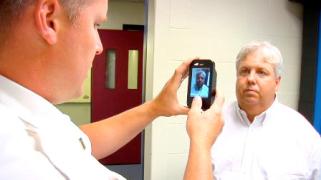Exactly what sorts of objects and substances ARTEMIS is able to pick out of its region-spanning hyperspectral cubes is a military secret. However this briefing pdf given in 2006 by US airforce lab officials suggests that it was expected to pierce overhead camouflage that would deceive optical or thermal sensing; that it would be able to spot disturbed earth and “concealed adits” (that is cave or tunnel entrances invisible from above) and generally “detect and identify” unspecified “targets”.
Evidently the TacSat-3 can do at least some of this, as we now learn that following a year as an experiment it has proved so successful that it is now being handed over to US air force Space Command to become a full-time operational asset – America’s first hyperspectral spy sat.
*****
If true, this could be pretty significant. A satellite like this could also be used to identify minerals in certain areas, enemy emplacements, tunnels, you name it. I am sure there will be an army of analysts going over the information, as well as super computers, all with the focus of uncovering the battlefield secrets of our wars. That is pretty cool if it can work as advertised.
It also looks like a commander in the field who has a AN/PRC 117F, can actually tap into the feeds of this hyperspectral satellite, and get some close to real time information on his battle space. I am sure the satellite can identify all sorts of stuff that might be valuable to a commander out in the field, and give him the heads up on targets and things of interest. There might even be some non-military applications for this thing, that could help out the commander as well. (farming, road construction, etc.)
Also, a satellite like this might help to find Osama Bin Laden. I mean if it can find caves or tunnels, then we could conceivably find the coordinates of every tunnel in our areas of focus in Pakistan or Afghanistan. You could also probably fine tune the satellite to pick up the signatures of any of the tools of warfare that these guys would have. Sat phones, bombs, gun metal, etc. Who knows, but I do know that this project was given top priority and fielded at a break neck speed. Interesting stuff.
For this industry, the one thing that this satellite could do, to help out the enormous contractor logistics battle we are fighting, is to watch the roads for us, and somehow get that information out to the masses if there is an IED hole or whatever. Stuff like this could not only save the lives of military folks, but contractors as well, and increase the success rate of cargo delivery.
Finally, one idea for this thing is to use bomber drones who can drop sensor drones on top of these targets identified by the satellite. The idea being is that you could use thousands of sensor drones (that are also equipped with warheads), and land them on these targets identified by the satellites. If these sensor drones actually had sniffers or small cameras to identify wires or whatever, the sensor drone could report that to the operator and they could determine the course of action. What is great about sensor drones like this, is that you could use them to detonate the IED, or to kill the enemy if they try to destroy the drone.(use it drone archer style) If it is a child or innocent that is just curious, just fly the sensor drone away to keep it out of their hands. Or give commands through the thing, and tell them to stay away. If you cannot recover the drone, then just blow it up or use a safer self destruct ‘elephant chisel’ mechanism. And the way things are going now, drones that could perform this task are getting cheaper, smaller, smarter, faster, and more feasible for this kind of mission. –Matt
——————————————————————
New prototype US spy satellite rushed into active use
‘Hyperspectral cube’ eye can spot buried bombs, tunnels
By Lewis Page
June 11, 2010
An experimental “hyperspectral” spy sat which is able to detect buried roadside bombs and concealed cave or tunnel entrances has been handed over to the US forces for operational use in the Wars on Stuff.
The TacSat-3 was launched aboard a Minotaur-1 rocket along with several other small satellites from Wallops Island, Virginia, in May 2009. The TacSat was designed to prove the US concept of “operationally responsive space”, where a military user can make a request and a small inexpensive satellite can be in a suitable orbit within days rather than months or years.
Thus the TacSat is designed to be fitted with a variety of different payloads as required by an operational commander. TacSat-3, as a prototype, carried one in particular known as the Advanced Responsive Tactically Effective Military Imaging Spectrometer, or ARTEMIS. This is a “hyperspectral” sensor able to detect not just visible light but infrared and ultraviolet as well.
The idea of hyperspectral sensing is not, however, merely to “see” in the usual sense of optical telescopes, infrared nightscopes and/or thermal imagers. This kind of detection is used on spy satellites and other surveillance systems, but it suffers from the so-called “drinking straw effect” – that is, you can only view a small area in enough detail to pick out information of interest. It’s impossible to cover an entire nation or region in any length of time by such means; you have to know where to look in advance.
(more…)

